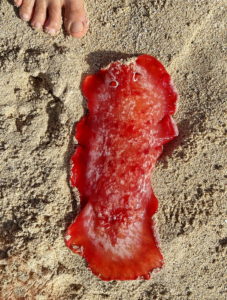
The 12-inch-long redmargin Spanish dancer sea slug, Lanikai Beach ©Susan Scott
July 5, 2021
During a recent morning beach walk, one of my neighbors caused me to break into a run with this announcement: “Someone found a really big Spanish dancer that looks like it’s in trouble.”
I rarely see these nudibranchs (NOODIE-branks), or sea slugs, while snorkeling, but for some reason, they commonly wash up on Lanikai Beach. Usually, the ones we find are only a few inches long or less. If they’re still alive after they tumble ashore, we walk them past the shore break and let them go.
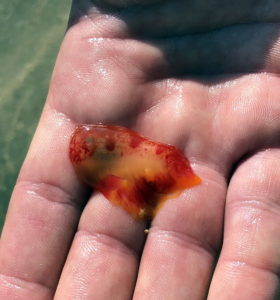
A tiny Spanish dancer nudibranch we found on the beach. ©Susan Scott
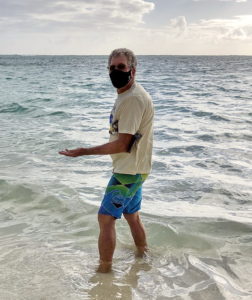
Craig taking the baby sea slug home. ©Susan Scott
With luck, the little snails will grow up and make more of their kind.
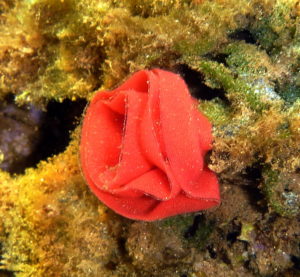
A Spanish dancer’s egg case looks like a flower. Like the parent that produced it, the eggs contain sponge toxin distasteful to predators. ©Susan Scott
This one, however, called a redmargin Spanish dancer (Hexabranchus pulchellus) was huge. At about 12 inches long, that’s as big as they get.
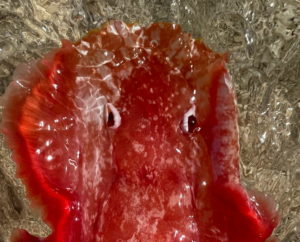
The two organs near the front of Spanish dancers are tentacles that help the animal find food, and others of their kind for mating. Our large Spanish dancer had white circles around its tentacles, giving it a kind of “wide-eyed” look. ©Susan Scott
Another Hawaii species, the yellowmargin Spanish dancer (Hexabranchus aureomarginatus) grows to about 8 inches long. It’s less marbled in color, but no less striking. As its name implies, the yellowmargin Spanish dancer has yellow or cream colored edges to its boneless, shell-less body.
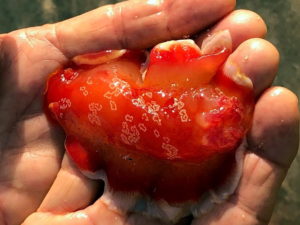
A beached yellowmargin Spanish dancer. ©Susan Scott
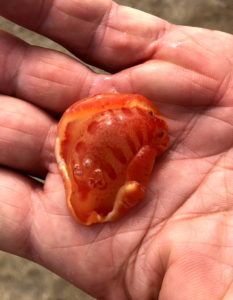
An even smaller yellowmargin Spanish Dancer we found on Lanikai Beach. Why so many of these nudibranchs wash up there is unknown. ©Susan Scott
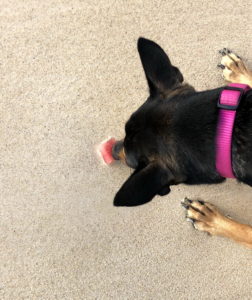
We are so accustomed to finding Spanish dancers stranded on our beach that we immediately scolded our little dog, Pixel, for bothering this one. We apologized to her when we discovered it was a piece of watermelon. ©Susan Scott
It wasn’t hard to find the Spanish dancer in distress because its bright red body flexing and undulating in the clear shallows (youtu.be/SNOP1zVPDHk) had drawn a small crowd. When the animal washed ashore, I picked it up for a rescue.
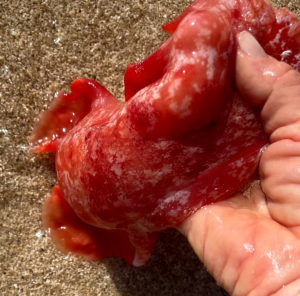
Spanish dancers eat red sponges that contain natural toxins. As a result, these nudibranchs, and their egg cases, are also toxic to eat. This protects the creatures from marine predators, but Spanish dancers, and all other nudibranchs, are safe to touch. They’re soft bodies, however, are fragile because the animals have no skeletons, and their frilly gills are exposed on their backs. If you have to handle a nudibranch to save its life, be gentle.

Some redmargin Spanish dancers are more mottled in color. This one, a past Lanikai rescue, had more white in it than usual. ©Susan Scott
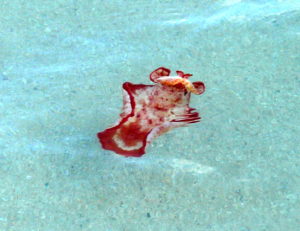
Dancing to safety. ©Susan Scott
A friendly bystander volunteered to take the large Spanish dancer into deeper water: youtu.be/9bC8kxTRw6Y After the release, even from a distance, we spectators could see the red nudibranch twirling and swirling in the calm water, hopefully to live another day.
“You live here?” a visitor said to me as he marveled over the sea slug and the scenery at Lanikai Beach. “How lucky you are!”
I know. And when I’m watching a Spanish dancer dance, I appreciate that fact more than ever.
(For my latest Kolea news, go to www.koleacount.org/june-plovers-2021/ Subscribe on the Home page there to get email notices of updates.)